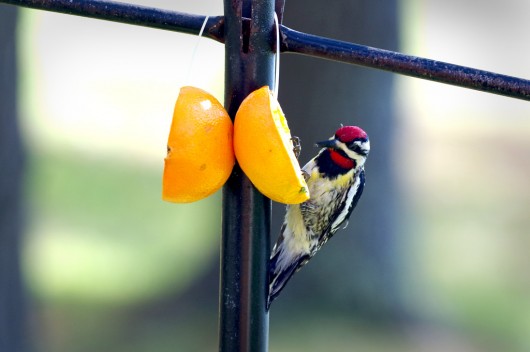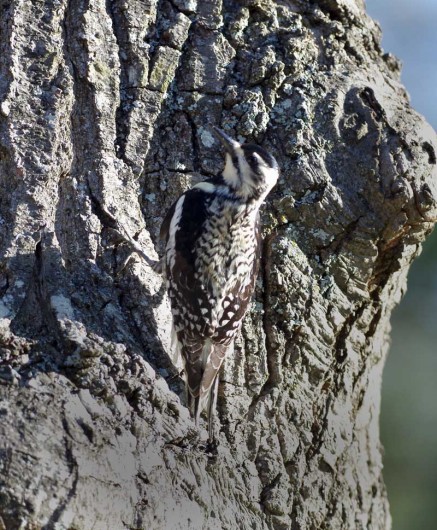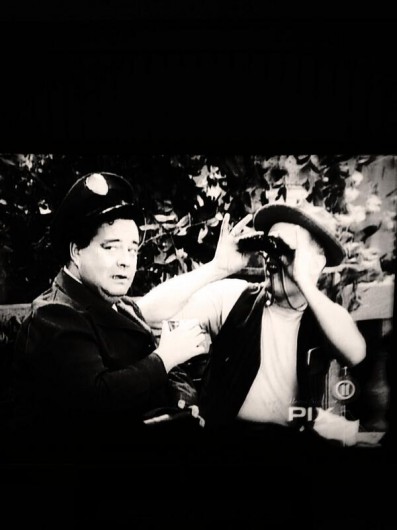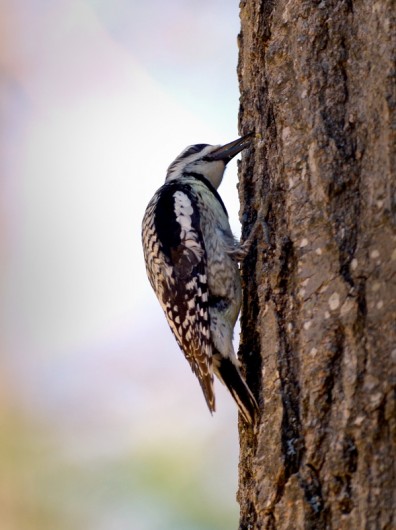 The Orioles are back in town, so we’ve hung out the orange. But the Orioles are busy eating the hummers’ food. And now the Yellow-bellied Sapsuckers are eating the Orioles’ food. What the heck!
The Orioles are back in town, so we’ve hung out the orange. But the Orioles are busy eating the hummers’ food. And now the Yellow-bellied Sapsuckers are eating the Orioles’ food. What the heck!
This is a male, with the more yellow belly than his partner and that nice red neck patch and top patch. The female has a white throat, but still has a red top patch. Apparently the pair has a young one. As my brother Tom pointed out to me, the juvenile has no developed red patches. It must have been hungry because it stayed feeding at the orange for ten-minute stretches. We began to think maybe the orange had fermented and the bird was intoxicated. It even continued eating when we moved within a few feet of the feeder.
Here’s the juvenile–clearly better camouflaged than mom and pop..
 Ah yes, every Baby Boomers’ introduction to the Yellow-bellied Sapsucker: Jackie Gleason’s The Honeymooners.
Ah yes, every Baby Boomers’ introduction to the Yellow-bellied Sapsucker: Jackie Gleason’s The Honeymooners.
 Ed Norton: As I live and breathe, a Yellow-bellied Sapsucker. * * * got to make an entry in my bird book here. I just seen a Yellow-bellied Sapsucker. Bird seen: Yellow-bellied Sapsucker. Place where seen: Central Park. Only one thing that bothers me, they’re not supposed to be within 3000 miles of here.
Ed Norton: As I live and breathe, a Yellow-bellied Sapsucker. * * * got to make an entry in my bird book here. I just seen a Yellow-bellied Sapsucker. Bird seen: Yellow-bellied Sapsucker. Place where seen: Central Park. Only one thing that bothers me, they’re not supposed to be within 3000 miles of here.
Ralph Kramden: Well how do you know it’s a Yellow-bellied Sapsucker? Don’t forget, last week you saw a robin with a wishbone in its mouth and you said it was a chicken hawk.
Ed Norton: Nonetheless, I’m sure it’s a Yellow-bellied Sapsucker.
Ralph Kramden: Why are you sure it’s a Yellow-bellied Sapsucker?
Ed Norton: What else could it be? It’s got a yellow belly and it was suckin’ sap.
Ralph Kramden: I don’t know why a man of your age watches birds.
Ed Norton: Why shouldn’t I watch them, they watch me, don’t they?
Ralph Kramden: The only bird that watches you, Norton, is a woodpecker.


Hi Noreen, About the Yellow-bellied Sapsucker…both the male and female have red on their heads, and the male has the red throat, the female’s is usually white. It’s only the juvenile who has no red on it – so I think that’s probably a juvenile in the last two pictures. I don’t see them around my house very often, as I’m only in the migratory route, but Long Lake is just far enough north to be in their breeding grounds.
Yipes…you are correct! Thanks so much. I will fix the post!
I love looking at your sight about long lake creatures. Always so interesting. It the only sight that I follow.
@julia…thanks so much for letting me know that you enjoy my blog!